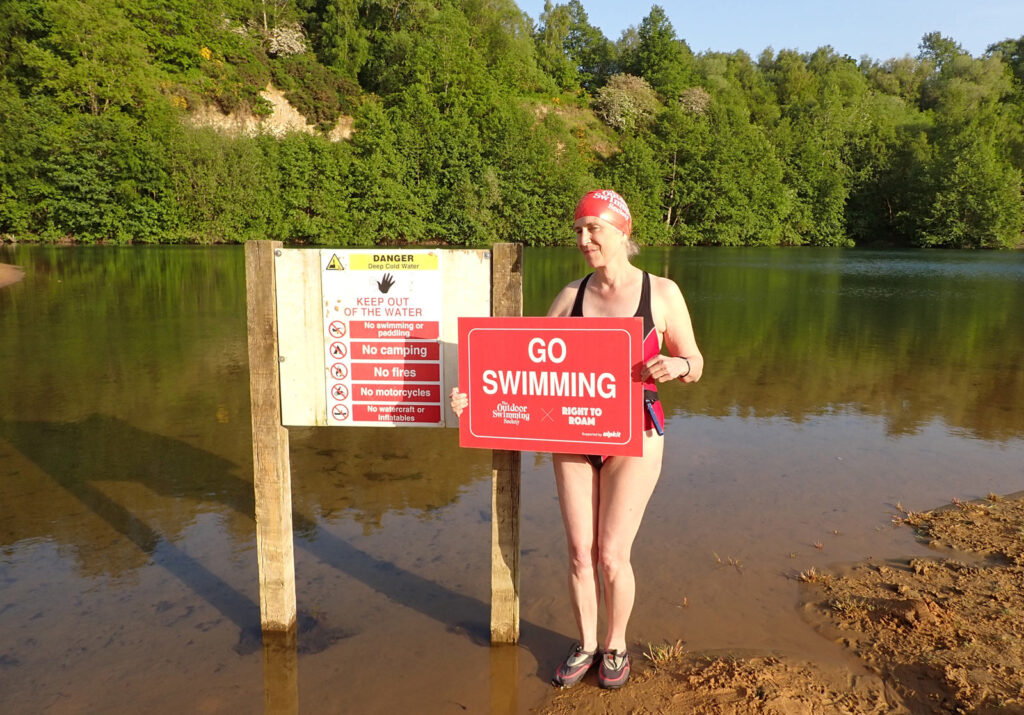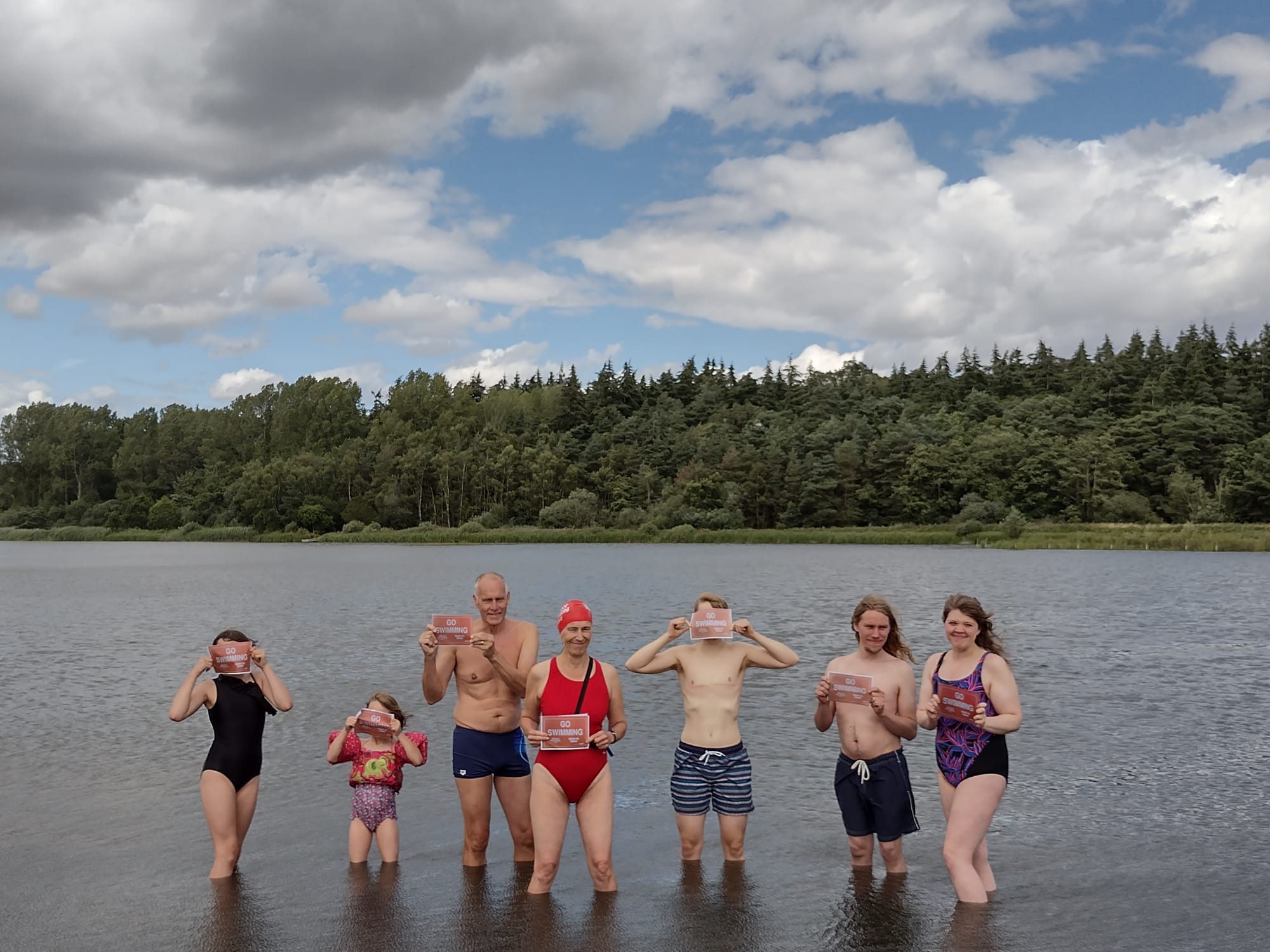Wild swimming is popular, and it’s here to stay. It’s not dangerous, and there are a few key tips swimmers can follow to stay safe and avoid the risks. Accurate information and improved access are the best ways to help people learn about swimming safely and responsibly. We need more access and clearer rights – ideally a Right to Roam on land and in water as in Scotland – and meanwhile we need to Go Swimming!
(Note: I am using ‘wild swimming’ to distinguish from other sorts of outdoor swimming, to mean swimming that is definitely not in a supervised setting. This focuses on inland waters in England)
Popularity increasing, benefits realised
In the last few years the popularity has increased massively, as loads of people are discovering the benefits of cool water, adventure, fun, fitness, being close to nature, and much more
Swimming safely: take responsibility, tips to avoid risks
There are some risks, and it’s important to know that you have responsibility for your own safety. You can find tips to keep yourself safe from various sources, including local informal swim groups, the Outdoor Swimming Society, my website (for example https://www.outdoorswimmingsociety.com/10-tips-for-summer-swim-safety/ ; https://www.imogensriverswims.co.uk/blog/issues/swim-play-in-water-safely-q-a/ )
Is wild swimming ‘dangerous’?
No, it’s very low risk, when you consider the millions that do it every year without coming to harm. Some authorities, landowners, safety organisations and the media can present it as dangerous, but the facts do not support that (https://www.outdoorswimmingsociety.com/drowning-statistics/)
The best way to make sure that wild swimmers can be safe? Information and access
Giving basic information on the key risks and how to stay safe is important, so it’s surprising how often some organisations list a number of risks without explaining how people can swim safely and avoid coming to harm.
Just knowing a few key things – that it’s best to check where you’re going to get out before you get in, get in carefully at first, only jump after you’ve got used to the water temperature and checked for obstructions and depth, staying near to shore or in your depth if not a confident and experienced swimmer, and knowing about float to live if you fall in or panic – is usually enough to stay safe.
Access is crucial, as giving people the chance to swim outdoors, especially from an early age preferably with family, means that they can learn these basic tips and understand how to stay safe.
Saying ‘stay out’ or ‘no swimming’ does not keep people safe, it does not give information or the chance to learn, and can in fact encourage unsafe and irresponsible behaviour (the attraction of the forbidden), and mean that people find more hidden and less safe places to go.
This article, Inland water access = a safer society? outlines how not having access has meant generations not getting the chance to learn swim safety, https://www.peakswims.co.uk/blog/blog-post-wateraccesssafety. (See also my earlier post about swim safety, https://www.imogensriverswims.co.uk/blog/issues/swim-safety/)
Access to water also helps people respect the environment, and being connected to nature means that people are more likely to care about it and care for it.
Access to water to swim: too few places, under threat, disputed and complex. But we must assert the rights we have!
We have too few places to swim for those that want to do so, especially as the popularity of wild swimming increases. Places we have can be under constant threat because of misunderstandings about safety, liability, and how responsible visitors and swimmers might be.
There are places where the rights are clear, many others where they are disputed, but also many where people have traditionally swum and this is accepted. It is important to assert the rights we have. See https://www.outdoorswimmingsociety.com/is-it-legal/; for rivers https://www.outdoorswimmingsociety.com/the-3-percent-access-myth/; for reservoirs https://www.outdoorswimmingsociety.com/sixteen-reasons-reservoirs/.
What would improve access to places to swim? A right to roam!
Labour promises to implement right to roam, along the lines that have been in place for several years in Scotland, and this would include the right to access water (https://www.outdoorswimmingsociety.com/right-to-roam-breakthrough/). Campaigning groups Right to Roam (https://www.righttoroam.org.uk/), Bluespace (http://bluespaceaccessandconservationtrust.org/About-Us/ and on Facebook https://www.facebook.com/groups/BAThE), and many others are campaigning for this to happen. The Outdoor Swimming Society Inland Access Manifesto calls for freedom to swim.
What can we do (meanwhile) to improve access to places to swim?
The most important thing to do is to Go Swimming, and keep swimming where we can responsibly access the water. This is a key lesson from experience of swimmers around the country, included in this roundup of Inland Access December 2022 on the OSS website (https://www.outdoorswimmingsociety.com/inland-access-round-up/).
Anyone interested in negotiating to improve access, or to protect existing access, or to get or share advice or info on this, is welcome to join and discuss in the Inland Access Group – Outdoor Swimming Society group on Facebook, at https://m.facebook.com/groups/219625724751074?id=219625724751074&ref=content_filter&_rdr.
When we Go Swimming we do this responsibly, respecting the environment and the local community, going the extra mile by picking up litter for example, and taking responsibility for our own safety, and following the Outdoor Swimmers Code (https://www.outdoorswimmingsociety.com/outdoor-swimmers-code/). In the many places where it is not ‘allowed’, nearly always without good reason, swimmers might need to support each other as this is not easy for those feeling vulnerable, not wishing to face conflict, potentially more likely to be challenged for doing so, or less able to physically navigate a barrier, more difficult entry point or a longer way round to the entry point. Local informal swim groups are good supportive communities (https://www.outdoorswimmingsociety.com/uk-wild-swimming-groups/; in East Anglia https://www.imogensriverswims.co.uk/blog/issues/z-more-info-on-outdoor-swimming-september-2020/#local-swim-groups).
When we Go Swimming, in numbers, the fact that we do so cannot be ignored. There are many examples where the presence of swimmers is recognised and seen as inevitable or positive.
So Go Swimming!


